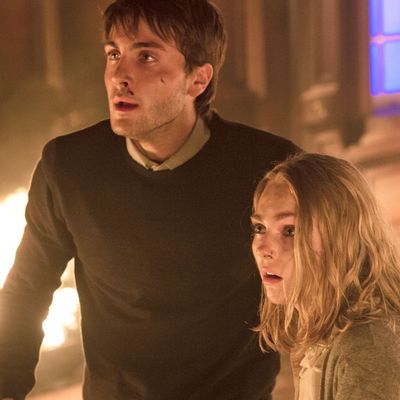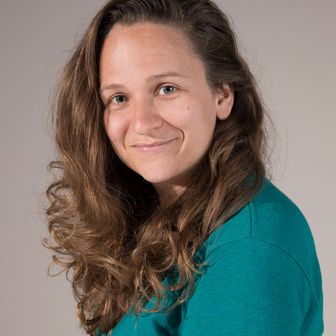
This year’s horror cinema has been a zombie-heavy slate, not to mention the inexplicable number of mutant Nazi movies coming in the back half of 2018. But amid all the flesh-eating is Down a Dark Hall, a good old-fashioned ghost story based on the novel of the same name by Lois Duncan. The stylish haunted-house film from Spanish director Rodrigo Cortés focuses on a group of teen girl misfits who end up at a posh alternative school after they’ve exhausted all the other educational and therapeutic resources in their daily lives.
The house, called Blackwood, is run by Madame Duret (Uma Thurman being wonderfully extra with a mostly French accent), and while she seems like the one who will finally channel each of their unique energies into something productive, what she’s actually doing is preying on the castoffs, who possess powerful sixth senses they’ve been repressing their whole lives. Basically, it’s a fancy gothic prison, and the beautiful, worldly warden is running experiments on the inmates.
Dark Hall plays like a classic fairy tale, but there’s one moment that sneaks an adrenaline shot into a movie otherwise fully dedicated to the terror of dread. In the film’s biggest conventional thrill, our heroine, Kit (AnnaSophia Robb) is finally willing to confront the true nature of Blackwood. After following a suspicious sound, she ends up running through a corridor pursued by shadows. It’s a four-minute-long single-tracking shot, but the camera moves like it’s on a swivel, keeping the point of view on Kit’s gaze, and keeping the danger hidden from view — until, finally, the frame shifts and lands right on the face of a disfigured ghost man screaming just inches away from her face. It’s a perfectly choreographed jump scare.
“The scare is about anticipation,” says Cortés. “After four minutes of anguish, you have a jump, then you’re gonna feel relief. [But] nobody is going to save you for those four minutes of tension.” Vulture chatted with the director about designing the centerpiece scare of Dark Hall and how he staged the hour-long buildup to its execution.
Play the Long Game
Jump scares have a simple setup and payoff structure. Similar to slowly blowing up a balloon until it reaches its bursting point, when the thing finally pops it scares the life out of you, even though you totally knew it was coming. In the case of Dark Hall, Cortés starts slowly blowing up that balloon as soon as his teen stars arrive at Blackwood. The scene that actually features the big scare only lasts few minutes, but by the time it arrives, the director has already been silently inflating that latex bomb for nearly an hour.
“This threatening feeling has to do with changing the balance of the house,” says Cortés of his subliminal approach to rising action. “Blackwood is almost a nice place. It’s not Dracula’s mansion at all. It’s summer. The light is optimistic, and little by little, it changes. You go from summer to the autumn, so the light weighs more. It’s grayer. Also the music changes, and the other side of the house grows and grows. At the beginning there’s a whisper that you might have heard, or not. Then it’s a dark corner, and maybe you saw something there, or maybe you imagined it. Then it becomes shadows, then shapes, and the tone and balance changes, and this other Blackwood emerges.”
As Kit runs through the corridor, those shadows and shapes you’ve seen fading in and out give way to a real, screaming monster, which finally allows Blackwood to be presented in its true terrifying form, and sets up the final act of the narrative.
Stay Analog
In any ghost story, there’s a risk you’ll see too much, too soon. And even worse: You’ll build up the evil in your mind and be disappointed by some poorly rendered digital monster that knocks the suspension of disbelief right out of you. That’s why it was so important to Cortés that his spirits be as practical as possible. Of the corridor scene, he emphatically says, “There’s no CGI at all. It’s completely physical,” which means every shadow and figure you see in the entire long tracking shot was done on camera. They even built Blackwood’s interiors from scratch and tweaked it just enough as the story unfolded to keep the audience destabilized.
“We built everything on three huge soundstages, so we designed the whole house,” says the director, who took inspiration for how to light the film from Spanish painters like Goya and Diego Velázquez. “We also changed the design little by little so the house was alive, including the corridors and the hallways, and the light changes while the sound design and music does. It affects you because it’s physical and not subjective at all. Your interpretation might be subjective, but all those elements are there and are affecting you.”
Don’t Patronize the Kids
Dark Hall is adapted from a young-adult novel, but this isn’t one of those starring–Jack Black scares-for-kids movies. Some of our greatest modern ghost stories — The Orphanage, Pan’s Labyrinth, The Devil’s Backbone, The Others — come from Latin directors blending dark dramas with the fantastic, and centering the narrative around children. “I worked with very young actresses, but I still work with them like they were 55-year-old actresses, because you don’t patronize children,” says Cortés, who knows that the teen audience his movie is targeting will pick up on even the slightest bit of condescension, and cites non-kid-friendly auteurs like Roman Polanski and Peter Weir as his inspirations for shooting. This makes the stakes feel high in a moment like the corridor scene, because Cortés has let you know Kit won’t be spared any horrors just because of her age. “You don’t patronize these actors, because they play characters who have very dark and deep places inside them.”
Shoot With Purpose
The corridor scene was the very last shot on the very last day of principal photography for Down a Dark Hall. Cortés had two microphones — one to guide the camera crew and one to direct Robb — so neither could hear the other’s instructions, but he could ensure the dolly com moved “in perfect synchronization with AnnaSophia’s reaction.” The director knows everyone loves a fancy single take, but it was crucial to him that it not just be a production stunt. “The camera becomes a pencil in a way, so you try to write with it,” says Cortés. “The reason why it’s a single shot is not because you want to show that you can do it, but because you want people to feel it in real time, so they are completely inside that scene. You do not want to create some kind of fake affect. The audience is there, because camera means self.”
And much like the tracking shot, Cortés didn’t want the big scare itself to just be a novelty. “I appreciate a good jump like everybody, but this is not something I’m interested in so much as a director. I much prefer atmosphere,” he explains. “But I did want to have one big jump, and it shouldn’t be just like a slamming door. Everything is about setting it up and building the moment.” So did it work? The crew certainly thought so. On the first take people watching the monitors on set were so caught off guard by the appearance of the disfigured man that they screamed along with Robb.





